Expect Many English Speaking Visitors to Croatia in 2021, says Google
September 25, 2020 - Croatia is the 14th most searched holiday destination in the world for next year. With over 810, 000 searches on Google, the country should expect a big return of English speaking visitors to Croatia in 2021
Aside from the drop in numbers, the country's accessibility and the implementation of epidemiological guidelines, the biggest effect the Coronavirus pandemic had on Croatia's tourist season of 2020 was the change in visitor demographic. The British, Americans, Canadians and Australians largely stayed away. All that looks set to change next year as Google indicates a big return of English speaking visitors to Croatia in 2021.
Over 810, 000 searches have already been made of Croatia as a holiday destination for 2021 on Google, informing that many thousands are already researching or actively planning a trip. Croatia ranked 14th among the most searched for 2021 destinations, trailing slightly behind the likes of Italy, the Maldives, Mexico, Thailand, Spain and Greece.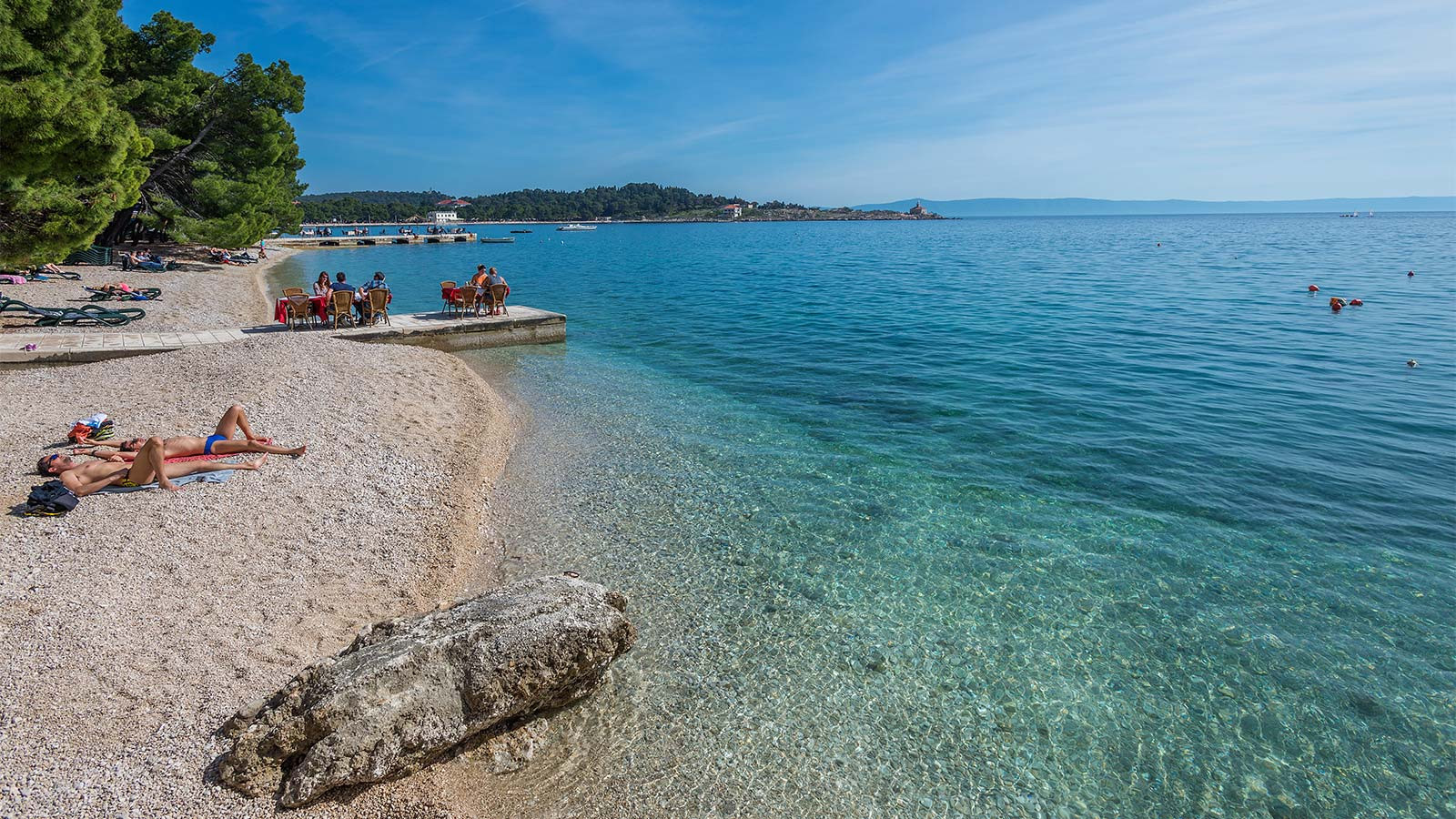 Their language mostly absent from beautiful Adriatic beaches in 2020, English speaking visitors to Croatia in 2021 look set to return © Croatian National Tourist Board
Their language mostly absent from beautiful Adriatic beaches in 2020, English speaking visitors to Croatia in 2021 look set to return © Croatian National Tourist Board
The good news for the return of English speaking visitors to Croatia in 2021 was published by the Electronic System for Travel Authorization (ESTA). The data has been taken from a period starting not before March 2020. This means that all searches took place in full knowledge of the ongoing Coronavirus and epidemiological situation. English speaking visitors are undeterred.
Iva Bahunek, the head of the Croatian Tourist Board in Los Angeles has not had the easiest of tasks since the pandemic began. Her appointment is a relatively recent one. Nevertheless, she has clearly done an excellent job of promoting Croatia as a destination for American tourists in 2021. She confirmed the trends are correct - that US citizens are ready for international travel again - by analysing data from the large American travel insurance company Squaremouth. 65% of all reservations for next year refer to international destinations. Iva Bahunek accepting her Mediterranean Stars Award for outstanding achievement in promoting Mediterranean tourism, awarded at the 6th Mediterranean Tourism Forum in Malta, 2019. She now heads the Croatian Tourist Board in Los Angeles and analysed data which backs up Google's prediction for a return of English speaking visitors to Croatia in 2021
Iva Bahunek accepting her Mediterranean Stars Award for outstanding achievement in promoting Mediterranean tourism, awarded at the 6th Mediterranean Tourism Forum in Malta, 2019. She now heads the Croatian Tourist Board in Los Angeles and analysed data which backs up Google's prediction for a return of English speaking visitors to Croatia in 2021
Indications from the British market are the same. Total Croatia News recently published an interview with Vedran Meniga, organiser of a music festival site in Sibenik that successfully hosted over 10, 000 festival-goers in summer 2020. Sadly, they were the only ones who braved it. All of the international music festivals that usually take place on the Croatian coast cancelled their 2020 events.
But, some organisers of these festivals have been seen in Croatia over recent weeks, inspecting improvements to the famous The Garden Tisno festival site, which lies at the approach to Murter island. The festival's hugely popular beach stage has had walls removed, its space widened and now looks very well equipped to take on social distancing advice. Music festivals bring tens of thousands of people to Adriatic beaches each summer and the return of the international events will entice English speaking visitors to Croatia in 2021. On the below video you can see Alex Lowes of the Suncebeat Festival and Nick Colgan of The Garden Tisno recently checking out the new layout of the site in preparation for the return of festivals in 2021.
For the latest travel info, bookmark our main travel info article, which is updated daily.
Read the Croatian Travel Update in your language - now available in 24 languages
New Device Will Speed Up Coronavirus Testing Process, Worth Million Kuna
September the 25th, 2020 - The coronavirus testing process has been a thorn in the side of many people who claim it takes too long to get the desired result. These situations can occur in both emergencies and in order to travel somewhere, with different countries requiring different ''ages'' of the test result in order for people to be granted entry. A new device carrying a price tag of a whopping one million kuna is set to make the coronavirus testing process that bit quicker.
As Poslovni Dnevnik writes on the 24th of September, 2020, the new PCR device for the rapid analysis of swabs of persons who have been tested for coronavirus, worth 812 thousand kuna including VAT in total, was put into operation in the premises of the Teaching Institute for Public Health in Brod-Posavina County, continental Croatia. The device arrived at the institute back at the end of July this year, three microbiologists were trained to work on it, and its capacity is 24 samples in three hours. Funds for the purchase were provided by Brod-Posavina County itself.
The director of the institute, Dr. Ante Cvitkovic, emphasised that the new coronavirus testing device is intended primarily for emergencies, which can now be dealt with here in Croatia as well. So far, test results have been being waited for for 24 hours and sometimes even longer in the case of emergencies. Patients who need to be treated urgently by the hospital for certain reasons will be tested. In addition, the device will be used in situations where there is a positive employee within a healthcare facility.
''We will test health professionals to find out who can work and who can't. So far, these employees have been in self-isolation, now the results will be known much faster. Our colleagues will have much more room for maneuver to respond properly to the various challenges posed by COVID-19. Employees in homes for the elderly and infirm will also be a priority,'' said Dr. Cvitkovic. The head of the Department of Clinical Microbiology, Dr. Zeljka Siser, said that it was a fully automated system for molecular diagnostics.
For the latest travel info, bookmark our main travel info article, which is updated daily.
Read the Croatian Travel Update in your language - now available in 24 languages
EC Urges Member States to Take Anti-COVID Steps to Prevent Repeat of Last Spring
ZAGREB, Sept 24, 2020 - The European Commission on Thursday called on European Union member states to take all necessary anti-COVID steps to curb the spread of coronavirus and thus prevent another lockdown of the economy.
The Commissioner for Health and Food Safety, Stella Kyriakides, was quoted as saying in Brussels that "today's new risk assessment clearly shows us that we cannot lower our guard."
"With some Member States experiencing higher numbers of cases than during the peak in March, it is abundantly clear that this crisis is not behind us. We are at a decisive moment, and everyone has to act decisively and use the tools we have. This means that all Member States must be ready to roll out control measures immediately and at the right time, at the very first sign of potential new outbreaks. This might be our last chance to prevent a repeat of last spring," said the commissioner.
The European Centre for Disease Prevention and Control (ECDC) today published its updated risk assessment regarding the COVID-19 pandemic, alongside a set of guidelines for non-pharmaceutical interventions (such as hand hygiene, physical distancing, cleaning, and ventilation).
The EU member states are urged to step up testing and contact tracing, improve public healthcare surveillance, ensure better access to personal protective equipment and medicines and ensure sufficient health capacity, in line with the actions presented by the Commission in July.
Regarding the epidemiological situation, the ECDC report says that in Croatia, Czechia, Hungary, Bulgaria, Malta, Romania,
and Spain there is a high infection risk for the general population and a very high risk for vulnerable groups.
For the latest travel info, bookmark our main travel info article, which is updated daily.
Read the Croatian Travel Update in your language - now available in 24 languages
Minister Beros Confirms Downward COVID-19 Trend in Croatia, Delnice New Hotspot
September 24, 2020 - Croatian Health Minister Vili Beros confirmed a downward COVID-19 trend in Croatia, while he is worried about the state of Delnice as a new hotspot.
Index.hr reports that Health Minister Vili Beros said on Thursday ahead of the government session that epidemiological data still indicate a downward trend in the number of people infected with the coronavirus, while data on 266 people in hospital show no signs of overloading the health system.
Beros: There are no signs of overloading the health care system; I am worried about the jump in the number of patients in Delnice
"Today we have 232 infected; if we compare with last Thursday, when there were 250, it is still less. Last Thursday, there were 291, so the trend still shows a decline. Today, 266 people are hospitalized, 23 were admitted, and 30 were discharged, and still, there are no indications of overloading the health care system," Beros told reporters in front of Banski dvori.
However, he is worried about the jump in the number of patients in Delnice, among the users of the elderly home.
"This is what we say all the time, to monitor the epidemiological situation and to try to respond to any such micro-hotspots with adequate epidemiological measures," Beros said.
Minister Beros also spoke about the current situation with coronavirus at the government session.
Namely, Beros also told a government session that the number of people infected with the coronavirus had fallen for the third week in a row, while the rate of new infections had fallen by 5.2 percent in the past seven days.
"In Croatia, the number of newly infected people has fallen every week for the third week in a row. The rate of newly infected people in the last seven days is lower by 5.2 percent compared to the previous week," Beros said.
Of the total number of hospitalized, 9.71 percent are on a ventilator, up 1.71 percent from last week. The percentage of deaths relative to the number infected since the beginning of the epidemic is 1.68 percent.
With the arrival of autumn, the number of respiratory infections increases, so Beros called on citizens to adhere to epidemiological measures and timely vaccination against respiratory infections as the most effective prevention measures.
Current COVID-19 data in Croatia
There are currently 1,200 active patients with COVID-19 in Croatia, and 266 patients are in hospital.
In the past week, 219 patients were admitted, 23 were placed on a ventilator, and 223 patients were discharged. The average age of the infected is 49.2 years.
In the past week, 73 new coronavirus cases have been reported among healthcare workers, and 426 employees are in self-isolation.
Beros reported that the guidelines had been revised to shorten the isolation time for asymptomatic individuals. Thus, those with a mild or moderate clinical picture will now self-isolate for a minimum of 10 days.
Also, health care institutions should not condition the admission of patients who require hospitalization or conduct diagnostic and therapeutic procedures with a negative PCR test not older than 48 hours, especially in emergencies or when the delay may cause health deterioration. Recommendations were forwarded to family physicians and pediatricians.
The directors of hospitals have been informed that to reduce the waiting list for certain services, when issuing approvals for additional work, doctors consider the performed obligations in the home institution, said Beros.
For the latest travel info, bookmark our main travel info article, which is updated daily.
Read the Croatian Travel Update in your language - now available in 24 languages
232 New Cases and Four Deaths Reported in Croatia in the Last 24 Hours
ZAGREB, Sept 24, 2020 - Over the last 24 hours, of 5,351 tests performed for coronavirus, Croatia reported 232 new cases and four more COVID patients have died, while there are currently 1,200 active cases, the national COVID-19 management team said on Thursday.
There are 266 COVID-19 patients in hospitals, including 24 who are on ventilators.
In the past 24 hours, 296 people have recovered. Currently, 9,329 people are self-isolating.
Since February 25, when the first case of the infection was registered in Croatia, a total of 15,572 people have contracted the disease, 261 have died and 14,111 have recovered.
To date, 279,035 people have undergone coronavirus testing.
For the latest travel info, bookmark our main travel info article, which is updated daily.
Read the Croatian Travel Update in your language - now available in 24 languages!
Official COVID-19 in Croatia Weekly Report September 15-21, 2020
September 24, 2020 - The latest official COVID-19 in Croatia weekly report has been released by the Koronavirus government website, covering September 15-21.
CIPH report for the previous 7 days and daily report for the Republic of Croatia on the 21st of September 2020.
| Tested | Confirmed cases | Active cases | Recovered | Self-isolation | Hospitalized | On a respirator | Deaths | |
| 262.132 (+3268*) | 14992 (+70*) | 2002 | 12737 | 9159 | 297 | 24 (+5*) | 253 (+5*) | |
| A total of 146 people died in this epidemic wave. Most of the deceased had significant comorbidities or were of advanced age. The average age of the deceased in this epidemic wave is 76.3 years. Sixty-two people died on a respirator. * in the last 24 hours | ||||||||
There are currently 22 testing places in the Republic of Croatia that perform RT-PCR analysis and collect samples. All processed samples enter national Croatian Health Insurance Institute platform, which is accessible to all county public health institutes. County public health institutes submit data about positive cases, sources of infection and hotspots as part of their daily reports to the Croatian Institute of Public Health. The Croatian Institute of Public Health collects information about hotspots, hospital treatment of COVID-19 positive persons, COVID-19 positive patients on respirators and the deceased. You can find more about the test centers on the link.
Epidemiological indicators on 21st of September:
- Cumulative 7-day incidence rate for the Republic of Croatia: 34,1/100 000
- Cumulative 14-day incidence rate for the Republic of Croatia: 71,2/100 000
- Counties with a cumulative 7-day incidence rate greater than 50/100 000 inhabitants: Brodsko-posavska, Karlovačka, Ličko-senjska, Požeško-slavonska, Splitsko-dalmatinska
- Counties with a cumulative 14-day incidence rate greater than 100/100 000 inhabitants: Brodsko-posavska, Dubrovačko-neretvanska, Ličko-senjska, Požeško-slavonska, Splitsko-dalmatinska, Virovitičko-podravska
- Total number of tests in the last week: 37 118
- Share of positive tests in the total number of tests in the last week: 3,8 %
- Total number of tests and share of positive tests in total number of tests: 262 132, 5,7 %
- The number of new cases in intensive care per 100,000 inhabitants in the last 7 days: 0,49/100 000
- Number of deaths in the last week: 26
- Total death rate per 1 000 000 population: 61,9/1 000 000
Epidemiological situation in Croatia
Geographical distribution of new COVID-19 cases by counties
In a two-week period from 8th of September to 21st of September all counties recorded new cases of COVID-19 disease. The highest number of new cases are recorded in the Splitsko - dalmatinska County, followed by the City of Zagreb and Zadarska County. The lowest number of new cases were recorded in Koprivničko – križevačka and Varaždinska County. The Požeško - slavonska County also has the highest 14-day rate, followed by Splitsko - dalmatinska and Ličko – senjska County.
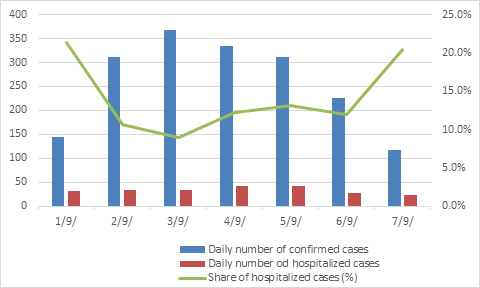
Epidemic by weeks, from 19 th – 30 th week of the epidemic
Table 1 shows the epidemiological indicators by epidemic week. The data shows that one of the most important epidemiological indicators, the rate of confirmed cases, the number of tests and the share of positive ones show a positive trend in the last 4 weeks. The confirmed case rate has been steadily declining since week 27 when it stood at 47.6 to 34 at week 30. The total number of tests has been growing continuously for the past 5 weeks, i.e. from the 25 th week. The proportion of positive people in total testing also fell steadily, falling from 12.5 in the 26 th week of the epidemic to 3.8 in the 30 th week.
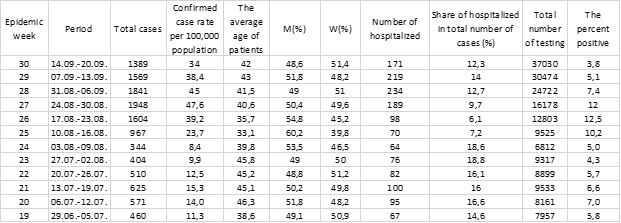
Table 1. Overview of the number of confirmed cases by weeks, from week 19 th –30th
Table 2 shows a set of indicators related to the severity of the clinical picture and the characteristics of deaths. The table shows that in the last 3 weeks there has been an increase in the average age of cases, the number of cases on the respirator and the death rate, which corresponds to previous findings that older people are more likely to develop more severe clinical forms and higher mortality in older age groups.

Table 2. Overview of patients on respirator and deaths by weeks, from week 19 th – 30th
Table 3 shows the incidence of the 7-day rate over the last three weeks with a limit of 50/100 000 inhabitants, which in some countries is taken as one of the criteria in assessing the epidemiological situation. In most counties, the 7-day rate is generally stable or slightly declining.
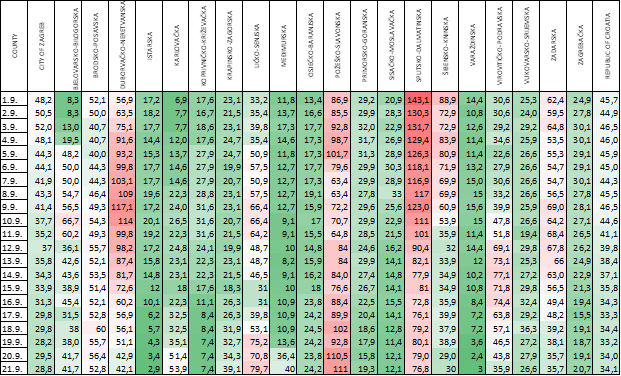
Table 3. Overview of 7-day incidence rates per 100,000 population in the last week
Clinical aspects - hospitalized, on a respirator and cured in the last week
Figure 2 shows the relationship between the daily number of confirmed cases and the daily number of hospitalized cases. Number of hospitalized cases per day ranged between a minimum of 17 and a maximum of 35, while the share of hospitalized cases in the total daily number of confirmed cases ranged from 7.3% to 42.9%.

Figure 2. Overview of the daily number of confirmed and hospitalized cases (15.9.-21.9.)
Figure 3 shows the proportion of hospitalized in the total number of weekly cases. Of the total number of confirmed cases in a given weekly period, 13.2% were hospitalized. In the same period, 20 people were put on a respirator, which makes 1,4% of the total number of confirmed cases.
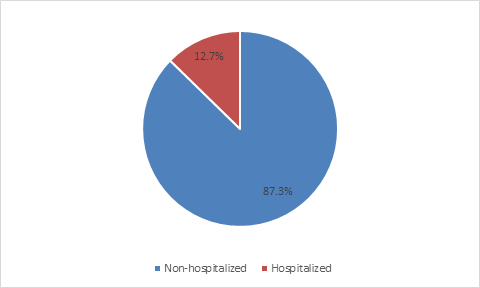
Figure 3. Relation of the total number of confirmed and hospitalized cases (15.9.-21.9.)
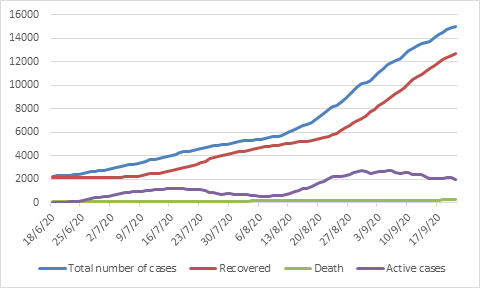
Figure 4. Movement of the total number of cases, recovered, deceased and active number of cases from 18.6.- 21.9.
Died from COVID-19,15 th of September – 21st of September 2020, age and sex
A total of 146 people died in this wave of epidemics. Most of the people who died had significant comorbidities or were of advanced age. The mean age of the deceased in this wave of epidemics is 76.3 years. Sixty-two people died on a respirator.
An overview of the situation is given in Table 4 and Figure 5.
Table 4. Distribution by age and sex of the deceased people
| AGE GROUP | 40-49 | 50-59 | 60-69 | 70-79 | 80-89 | 90-99 | 100+ |
| MEN | 1 | 10 | 17 | 32 | 21 | 4 | 1 |
| WOMEN | 0 | 0 | 9 | 15 | 30 | 6 | 0 |
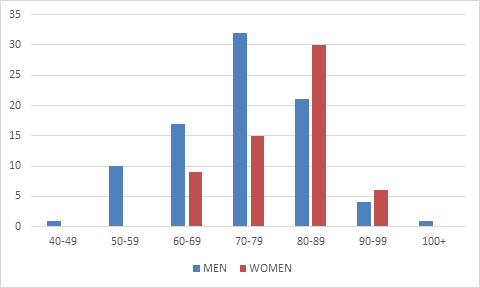
Figure 5. Age and sex distribution of deaths from COVID-19 in the period 29 th June – 21st of September 2020
In the last week, 26 people died, of which 14 (53.8%) were on a respirator. The distribution by age and sex in the last weeks is shown in Table 5, and by counties in Table 6.
Table 5. Distribution by age and sex of the deceased people in the last week
| AGE GROUP | 50-59 | 60-69 | 70-79 | 80-89 | 90-99 |
| MEN | 3 | 2 | 2 | 4 | 0 |
| WOMEN | 0 | 3 | 6 | 5 | 1 |
Hotspots
Table 6. New ill and deceased cases in the last week and total deaths and rates
| County | Number of new cases in the period 15.9.-21.9. | Incidence of new cases in the last 7 days on 100 000 inhabitants | Number of deaths in the period 15.9.-21.9. | Total number of deaths | Total mortality rate on 1,000,000 inhabitants | |
| CITY OF ZAGREB | 232 | 28,8 | 6 | 39 | 48,5 | |
| BJELOVARSKO-BILOGORSKA COUNTY | 45 | 41,7 | 0 | 1 | 9,3 | |
| BRODSKO-POSAVSKA COUNTY | 74 | 52,8 | 0 | 4 | 28,6 | |
| DUBROVAČKO-NERETVANSKA COUNTY | 51 | 42,1 | 2 | 12 | 99,0 | |
| ISTARSKA COUNTY | 6 | 2,9 | 1 | 13 | 62,3 | |
| KARLOVAČKA COUNTY | 63 | 53,9 | 0 | 2 | 17,1 | |
| KOPRIVNIČKO-KRIŽEVAČKA COUNTY | 8 | 7,4 | 0 | 16 | 148,5 | |
| KRAPINSKO-ZAGORSKA COUNTY | 49 | 39,1 | 0 | 2 | 16,0 | |
| LIČKO-SENJSKA COUNTY | 36 | 79,7 | 0 | 1 | 22,1 | |
| MEĐIMURSKA COUNTY | 44 | 40,0 | 0 | 0 | 0,0 | |
| OSJEČKO-BARANJSKA COUNTY | 67 | 24,2 | 2 | 26 | 93,8 | |
| POŽEŠKO-SLAVONSKA COUNTY | 75 | 110,5 | 1 | 4 | 58,9 | |
| PRIMORSKO-GORANSKA COUNTY | 55 | 19,3 | 1 | 4 | 14,1 | |
| SISAČKO-MOSLAVAČKA COUNTY | 18 | 12,1 | 2 | 5 | 33,6 | |
| SPLITSKO-DALMATINSKA COUNTY | 344 | 76,8 | 2 | 67 | 149,5 | |
| ŠIBENSKO-KNINSKA COUNTY | 30 | 30,0 | 1 | 7 | 69,9 | |
| VARAŽDINSKA COUNTY | 5 | 3,0 | 0 | 3 | 18,0 | |
| VIROVITIČKO-PODRAVSKA COUNTY | 27 | 35,9 | 4 | 7 | 93,0 | |
| VUKOVARSKO-SRIJEMSKA COUNTY | 41 | 26,6 | 2 | 16 | 103,6 | |
| ZADARSKA COUNTY | 60 | 35,7 | 0 | 7 | 41,6 | |
| ZAGREBAČKA COUNTY | 64 | 20,7 | 2 | 17 | 54,9 | |
| REPUBLIC OF CROATIA | 1394 | 34,1 | 26 | 253 | 61,9 | |
Continental Croatia
In the last week, new cases were recorded in all counties of continental Croatia, but mostly in the City of Zagreb, Požeško – slavonska and Brodsko - posavska County. The highest 7-day rates on 14 th of September were in Požeško - slavonska, Virovitičko - podravska and Brodsko – posavska County. In the last week, due to the appearance of new hotspots, a significant increase in the number of patients has been recorded in Karlovačka and Međimurska County. In Karlovačka County, a large number of patients are associated with activities related to choral singing, while in Međimurska County, the grouping of patients is associated with weddings. In Brodsko - posavska, Virovitičko - podravska and Zagrebačka County, groups of patients related to weddings are also recorded. This week, a smaller number of patients was recorded in connection with the prom party in Požeško – slavonska County and the home for the elderly in Sisačko - moslavačka County. Smaller groupings of patients associated with the spread of the disease in the workplace were recorded in several counties, while a larger grouping in the workplace, which currently records contacts, appeared in Krapinsko - zagorska County. Cases of the disease have also occurred in schools, but there has been no significant spread among students and staff. Cases of illness after returning from vacation are still recorded. Part of the sick people are cases imported from abroad and there is a large proportion of contacts of sick people.
Coastal Croatia
Cases of ill persons have been recorded in Coastal Croatia like in all counties as well. The highest number of patients was recorded in the Splitsko - dalmatinska, Zadarska and Primorsko - goranska County. The highest 7-day rate is in the Ličko – senjska, Splitsko - dalmatinska and Dubrovačko - neretvanska County. In most counties, after the end of the tourist season, the number of patients decreases again. In the Splitsko – dalmatinska County, there were also groupings related to choral singing and several smaller groupings related to the spread of the disease in the workplace. Related to the workplace, there have been also outbreaks reported in other coastal counties, but most of the contacts were immediately placed under health surveillance, so there wasn’t reported greater number of cases. As in the continental part, the cases of the disease were confirmed in several schools, but there wasn’t greater spread observed among students and staff. A significant proportion of patients are contacts of previously recorded cases.
Age-sex distribution of patients in the last week
In the previous week, a total of 1,394 people fell ill - approximately the same number of females (51.6%) and males. The same distribution by sex is present in most age groups, except in the age groups under the 7 years, where is the smallest number of patients and in the age group 51-65, in which women predominate (56.4%).
By age groups - 187 children fell ill and the 185 people of older age, which makes an equal percentage in the total number of patients, or 13%. The least affected were children under 1 year of age, a total of 2. The most affected were children of secondary school age, a total of 75. Adults made the largest share in the total number of patients last week 1022 (73.3%).
The distribution of patients by age did not change significantly compared to last week, except for a slight increase in children from 10.5% to 13.4%.
The full view can be found in Figure 6 and Table 6.
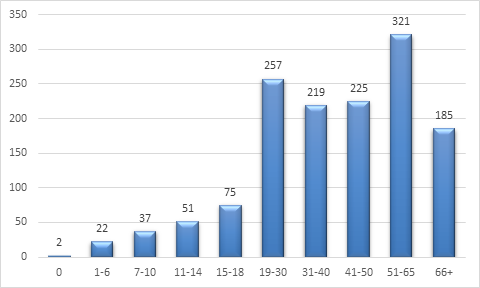
Figure 6. Distribution of patients in the last week by age groups
Table 6. Age and sex distribution of patients in the period 15.9.-21.9.2020
| Category | Age group | Number of cases men | Share of men (%) | Number of cases women | Share of women (%) | Total by age groups and categories | Share of age groups and categories in the total number of cases (%) | ||
| Kids | 0 | 2 | 100,0% | 0 | 0,0% | 2 | 187 | 0,1% | 13,4% |
| 1-6 | 6 | 27,3% | 16 | 72,7% | 22 | 1,6% | |||
| 7-10 | 17 | 45,9% | 20 | 54,1% | 37 | 2,7% | |||
| 11-14 | 25 | 49,0% | 26 | 51,0% | 51 | 3,7% | |||
| 15-18 | 34 | 45,3% | 41 | 54,7% | 75 | 5,4% | |||
| Adults | 19-30 | 133 | 51,8% | 124 | 48,2% | 257 | 1022 | 18,4% | 73,3% |
| 31-40 | 119 | 54,3% | 100 | 45,7% | 219 | 15,7% | |||
| 41-50 | 108 | 48,0% | 117 | 52,0% | 225 | 16,1% | |||
| 51-65 | 140 | 43,6% | 181 | 56,4% | 321 | 23,0% | |||
| Elders | 66+ | 90 | 48,6% | 95 | 51,4% | 185 | 185 | 13,3% | 13,3% |
| TOTAL | 674 | 48,4% | 720 | 51,6% | 1394 | 100,0% | |||
Measures
Measures to maintain physical distance, maintain hand hygiene and disinfection are still in force. Also, it is mandatory to wear face masks or medical masks indoors for all health workers and professionals, employees who work in social care system and the ones who work in hospitality facilities
Decisions of the Headquarters
- September 2 - Decision about the introduction of necessary epidemiological measures for the Sisačko - moslavačka County
- September 2 - Decision about the introduction of necessary epidemiological measures for the area of Požeško - slavonska County
- September 2 - Decision about the introduction of necessary epidemiological measures for the area of Koprivničko - križevačka County
- September 3 - Decision about the necessary measure of enhanced control of the implementation of the Guidelines for the Prevention and Suppression of the COVID-19 Epidemic for Social Service Providers in the Social Welfare System
- September 3 - Decision about the introduction of necessary epidemiological measures for the Krapinsko - zagorska County
- September 5 - Decision about the introduction of necessary epidemiological measures for the Bjelovarsko - bilogorska County
- September 7 - Decision amending the Decision on the necessary measure of limiting the working hours of catering facilities in the category "Bars"
- September 8 - Decision about amendments to the Decision about the introduction of necessary epidemiological measures for the Brodsko - posavska County
- September 8 - Decision about the introduction of new epidemiological measures for the area of the City of Otočac
- September 9 - Decision about amendments to the Decision about the introduction of necessary epidemiological measures for the area of Zadarska County
- September 9 - Decision amending the Decision about the introduction of necessary epidemiological measures for the area of Splitsko - dalmatinska County
- September 11 - Decision amending the Decision about the introduction of necessary epidemiological measures for the area of Dubrovačko - neretvanska County
- September 11 - Decision about the introduction of necessary epidemiological measures for the area of Virovitičko - podravska County
- September 11 - Decision about the introduction of necessary epidemiological measures for the Zagrebačka County
- September 14 - Decision amending the Decision about the temporary ban on crossing the border crossings of the Republic of Croatia
- September 14 - Decision amending the Decision about the introduction of necessary epidemiological measures for the Krapinsko - zagorska County
- September 14 - Decision amending the Decision about the introduction of necessary epidemiological measures for the area of Šibensko - kninska County
- September 21 - Decision about the introduction of necessary epidemiological measures for the Ličko - senjska County
CIPH recommendations
- Diseases and health conditions that may increase the risk for more severe forms of COVID-19 disease
- Selected health and organizational issues related to the work of preschool institutions, primary and secondary schools in the school year 2020/2021
- Recommendations for teaching at higher education institutions in the period of the COVID-19 pandemic with the application of anti-epidemic measures
- Organization of rest and food - Work of preschool institutions, primary and secondary schools in the school year 2020/2021 - additional clarifications
- Visors cannot replace masks except when a student / person has a problem with hearing impairment - Work of preschool institutions, primary and secondary schools in the school year 2020/2021 - additional clarifications
- Criteria for testing for SARS-CoV-2, termination of isolation and quarantine - Unified revised recommendations about priorities for testing for SARS-CoV-2, handling of contacts, termination of isolation and quarantine ("self-isolation")
- Terms of use of school sports halls by external users
- Instructions for the work of student dormitories with regard to the COVID-19 epidemic in the school year 2020/2021.
- Instructions for the prevention and control of the COVID-19 epidemic in student dormitories with regard to the COVID-19 epidemic in the school year 2020/2021.
Recommendations and measures on global and EU level
Europe
On 10 th of August 2020, ECDC released an updated version of the risk assessment:
ECDC has additional documents and information available: https://www.ecdc.europa.eu/en and https://www.ecdc.europa.eu/en/covid-19-pandemic
The number of cases and the 7-day cumulative incidence of COVID-19 confirmed cases worldwide can be found on the ECDC dashboard: https://qap.ecdc.europa.eu/public/extensions/COVID-19/COVID-19.html
Austria
Bundesministerium für Soziales, Gesundheit, Pflege und Konsumentenschutz – https://www.sozialministerium.at/Informationen-zum-Coronavirus/Neuartiges-Coronavirus-(2019-nCov).html
Netherlands
Government of the Netherlands - https://www.government.nl/topics/coronavirus-covid-19
National Institute for Public Health and the Environment - https://www.rivm.nl/en/novel-coronavirus-covid-19
Germany
Rober Koch Institut - https://www.rki.de/DE/Home/homepage_node.html
Slovenia
(gov.si) – https://www.gov.si/en/topics/coronavirus-disease-covid-19/
National Institute for Public Health – Slovenia - https://www.nijz.si/en
United Kingdom
gov.uk – https://www.gov.uk/coronavirus
NHS - https://www.nhs.uk/conditions/coronavirus-covid-19/
World
WHO provides comprehensive information and documents
WHO COVID-19-Dashboard: https://covid19.who.int/ and https://www.who.int/emergencies/diseases/novel-coronavirus-2019
Coronavirus disease (COVID-19) Weekly Epidemiological Update and Weekly Operational Update i Weekly Surveillance Report: https://www.who.int/emergencies/diseases/novel-coronavirus-2019/situation-reports and https://www.euro.who.int/en/health-topics/health-emergencies/coronavirus-covid-19/weekly-surveillance-report
Sources of information
https://www.hzjz.hr/
https://zdravlje.gov.hr/
Information about the global epidemiological situation
More about COVID-19 in other countries can be found and learned on the ECDC website: https://www.ecdc.europa.eu/en/geographical-distribution-2019-ncov-cases. The WHO Regional Office for Europe, the European Commission and the European Observatory on Health Systems and Health Policy have at their disposal the COVID-19 Health System Response Monitor (HSRM). There is information available about European countries and ways to respond to this epidemic. The focus is on health systems and public initiatives: https://www.covid19healthsystem.org/mainpage.aspx
For the latest travel info, bookmark our main travel info article, which is updated daily.
Read the Croatian Travel Update in your language - now available in 24 languages!
Germany Adds Lika-Senj County to Red List
September 24, 2020 - The Robert Koch Institute red list now includes the French regions of Center-Val de Loire, Brittany and Normandy, Lika-Senj County in Croatia, and Notranjsko-kraška region in Slovenia.
Novi List reports that on Wednesday, Germany added regions from 11 European countries to the list of high-risk areas, including Lika-Senj County, rejecting the last hope of reviving tourism at a time when many countries are threatened by a second wave of coronavirus.
The Robert Koch Institute list includes major tourist destinations such as the French regions of Center-Val de Loire, Brittany and Normandy, Lika-Senj County in Croatia, and the Notranjsko-kraška region in Slovenia.
The list also includes the capitals of Ireland, Portugal, and Denmark, the Dutch province of Utrecht, the Austrian state of Vorarlberg, most of the Czech Republic, the county of Gyor in western Hungary, and Romania's Covasna.
The inclusion in the list of risk areas usually follows when the Ministry of Foreign Affairs publishes recommendations against necessary trips to the region in question.
Germany warns against traveling to regions in the European Union where more than 50 are infected per 100,000 people per week.
Due to the spread of the epidemic, Germany has so far included Dubrovnik-Neretva, Požega-Slavonia, Šibenik-Knin, Split-Dalmatia, Brod-Posavina, Virovitica-Podravina, and Zadar counties on the list of epidemiologically risky areas in Croatia.
Declaring an area risky means that those returning from vacation must be tested for coronavirus and remain in self-isolation until they receive a negative test result.
On Wednesday, Croatia recorded 204 new cases, and the number of active cases in Croatia is 1,268. Among them, 278 patients are in hospital, of which 27 are on a ventilator. From Tuesday to Wednesday this week, 6,387 people were tested.
For the latest travel info, bookmark our main travel info article, which is updated daily.
Read the Croatian Travel Update in your language - now available in 24 languages
Croatia Awaits 690,000 Doses of Flu Vaccine in Pandemic Year
September the 24th, 2020 - The coronavirus pandemic is still holding the planet in its invisible yet devastating grip, and Croatia is busy preparing for the arrival of the dreaded influenza season and battling with the pandemic year.
As Poslovni Dnevnik writes on the 23rd of September, 2020, every year, Croatia orders more and more flu vaccines, and this year, which will be marked in memory as the pandemic year, we are waiting for the delivery of a total of 690,000 doses.
''To date, 460,000 doses of the flu vaccine have been ordered for the insured population, with an additional 130,000 of them which are due to arrive around December the 10th. There will also be 100,000 doses intended for pharmacies for sale. It will be sold for 68 kuna in pharmacies (op.a., price from Medoka). Vaccination against influenza starts around or after October the 15th,'' Marija Bubas, the assistant director of the Croatian Institute of Public Health told 24sata.
However, this is the first pandemic year in which the flu season will be mixed with the ongoing spread of the new coronavirus, so doctors recommend vaccination to everyone, especially to vulnerable groups. This will at least reduce the range of possible viruses they can contract. As always, it is recommended that chronic patients and the elderly be vaccinated against the flu.
The flu virus can cause a lot of issues for those people who are weaker and have more frequent complications, so when they contract the virus, viral or bacterial pneumonia can occur, which can ultimately mean a fatal outcome - explained the experienced infectologist Maja Capar.
No one is required to be vaccinated against the flu, but it is definitely recommended, especially during this pandemic year.
Capar describes how dangerous the flu can be:
''Although severe complications rarely occur, I remember our fellow nurse who also got encephalitis due to the flu, ie inflammation of the brain and ended up needing treatment in Zagreb. Fortunately, it all ended well and she recovered successfully,'' she recalled.
The measures that we must adhere to due to the coronavirus will help prevent both influenza and other viruses, Capar believes.
''These are all droplet infections that mostly spread in the same way. Until now, we've never worn masks, we've never kept a distance from each other and we've never disinfected our hands so regularly, and I believe that will prevent the spread of other viruses, not just the coronavirus,'' said Capar. Of the more than half a million doses of influenza vaccine mentioned, Zagreb alone expects a total of 85,000 doses.
The news is that this year, those who buy the vaccine at the pharmacy could be vaccinated immediately at the pharmacy, and not have to go to a doctor to have it done. This is a priority in all European countries because of the need to prevent the spread of the coronavirus infection.
For the latest travel info, bookmark our main travel info article, which is updated daily.
Read the Croatian Travel Update in your language - now available in 24 languages
Croatia Records 204 New Coronavirus Infections, Two Fatalities
ZAGREB, Sept 23, 2020 - Over the last 24 hours, there have been 204 new cases of the coronavirus infection and two deaths, and the number of active cases in Croatia stands at 1,268, the national COVID-19 management team said on Wednesday.
There are 278 COVID patients in hospitals, including 27 who are on ventilators. In the past 24 hours, a total of 6,387 tests have been performed and 828 people have recovered.
Currently, 9,314 people are self-isolating.
Since February 25, when the first case of the infection was registered in Croatia, a total of 15,340 people have contracted the disease, 257 have died and 13,815 have recovered.
To date, 273,684 people have been tested for coronavirus.
For the latest travel info, bookmark our main travel info article, which is updated daily.
Read the Croatian Travel Update in your language - now available in 24 languages
Krunoslav Capak Comments on Herd Immunity in Croatia, When We Can Expect It
September 23, 2020 - The director of the Croatian National Institue of Public Health, Krunoslav Capak, was a guest on Dnevnik Nova TV, where he spoke about when there would be herd immunity in Croatia, but also how many people have come into contact with COVID-19 in the country so far.
He says about 400,000 people have been in contact with the coronavirus
Capak said that serology tests during the spring showed that the number of those who came in contact with the coronavirus was 25 to 30 times higher than the number of those infected, i.e., those whose PCR test confirmed they were infected with the coronavirus. "About 400,000 people in Croatia have probably come into contact with the coronavirus," he said, adding that serology tests would be repeated.
Herd immunity only in the middle of next year
He added that herd immunity in Croatia could be achieved only in the middle of next year, i.e., when more than 50 percent of the population comes into contact with the coronavirus.
The sensitivity of PCR tests
He commented on the sensitivity of tests that detect coronavirus even in those cases where the virus is present in a very small amount, and the person is not contagious.
Capak says that the amount needed to detect the virus in infected people has been intensively researched lately.
"The problem is that it can be different with different PCR methods. Also, it significantly depends on the method and quality of sampling," he explained.
He also assessed that the situation in schools is good so far. "If we manage to maintain this pace of teaching, everything will be fine by the end of the school year," he concluded.
What does it mean when a person dies of COVID-19 but had numerous comorbidities?
He also explained what it means if a person died from COVID-19 but had numerous comorbidities.
"Certainly, the severity and length of the virus have an impact on the occurrence of those most severe forms of the virus. It can also be hypertension, which is a disease in itself, but is a factor in developing cardiovascular diseases. It doesn’t have to be some serious illness, but it is comorbidity. The duration of the illness certainly has an impact on the clinical picture, and even the outcome of the illness itself," he told Dnevnik.hr.
For the latest travel info, bookmark our main travel info article, which is updated daily.
Read the Croatian Travel Update in your language - now available in 24 languages
Join the Total Croatia Travel INFO Viber community.


